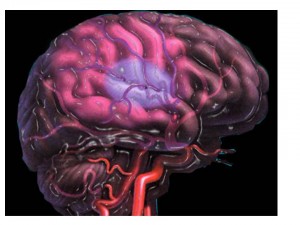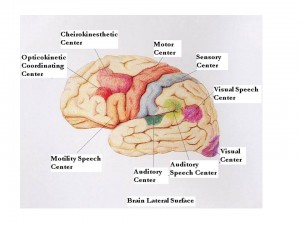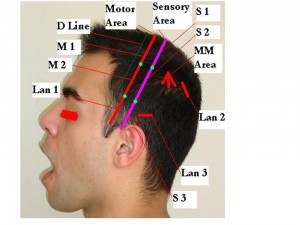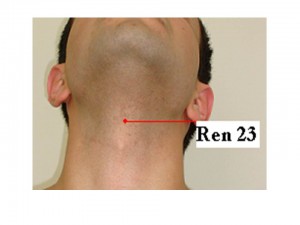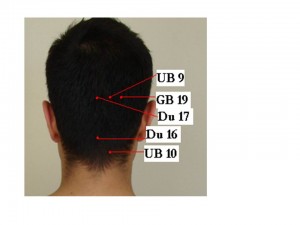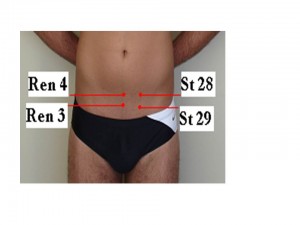News Letter, Vol. 4 (3), March , 2012, © Copyright
Jun Xu, M.D. Lic. Acup., Hong Su, C.M.D., Lic. Acup.
Robert Blizzard III, DPT
Rehabilitation Medicine and Acupuncture Center
1171 East Putnam Avenue, Building 1, 2nd Floor
Greenwich, CT 06878
Tel: (203) 637-7720
Fax: (203)637-2693
STROKE
healblog.net
William H., a seventy-year-old man with a history of hypertension and diabetes mellitus, came to my office complaining that his left arm and leg had been weak and almost paralyzed for two months. He told me that several months earlier he had experienced a sudden-onset headache. He had felt numbness and a tingling sensation in his left arm and leg, had difficulty opening both eyes, experienced double vision as well as slurred speech and dizziness, and his movements were clumsy. He was rushed to the emergency room where he was given a CT scan, which confirmed that he’d had a stroke. He was immediately admitted to the hospital and was given all possible medical treatment: anticoagulation medication, aspirin, and heparin. He remained in the hospital for a month and, upon discharge, he entered an acute rehab center where he was given exercises for his arm and leg. After a month he felt some improvement in his shoulder and hip joints, but still could not move his elbow, wrist, fingers, knee, or ankles. Finally, he consulted me for treatment.
Types and Causes of Strokes
Strokes usually occur in down time, and are usually heralded by all or some of these symptoms: a sudden onset of weakness or paralysis of the arms, legs, side of the face, or any part of the body. They can be accompanied by numbness and a decreased tingling sensation, with slurred speech, an inability to speak or understand someone’s else speech, difficulty reading or writing, blurred vision, difficulty swallowing, drooling, loss of balance or coordination, loss of memory, and vertigo. Some people also experience anxiety, depression, lethargy, nervous energy, or loss of consciousness. These symptoms are usually caused by a blockage in the brain artery, a narrowing of the small arteries within the brain, or a hardening of the arteries and arthrosclerosis leading to the brain.
Strokes are usually divided into three types.
- Type 1 is ischemic stroke, caused by a blood clot that blocks blood flow to the brain.
- Type 2 is hemorrhagic stroke, caused by bleeding inside of the brain that is secondary to ruptured aneurysms or uncontrolled high blood pressure.
- Type 3 is a transient ischemic attack (TIA). This symptom is seen for less than twenty-four hours, after which the person recovers and becomes normal again. A TIA is a warning stroke, or mini-stroke that produces strokelike symptoms, but no lasting damage. Recognizing and treating TIAs can reduce your risk of a major stroke.
Additional causes of strokes, with the exception of strokes caused by old age or high blood pressure, are described below.
- Coronary artery disease, which can lead to a heart attack or stroke, as can other heart conditions, such as endocarditis, fibrillation, heart failure, or heart valve diseases.
- Diabetes, which doubles the risk of stroke.
- High cholesterol, which causes hardening of the arteries.
- Overweight and diet. Consumption of high-fat food and alcohol abuse can cause a stroke. Too much alcohol increases blood pressure and cholesterol levels.
- Peripheral artery disease, such as carotid artery disease.
- Physical inactivity.
- Smoking, both primary and secondhand.
Treatments in Western Medicine
In Western medicine, strokes are treated as follows.
Ischemic Strokes
- In an ischemic stroke the doctor must quickly restore blood flow to the brain. This emergency treatment, together with medication, usually starts with aspirin, which has proved the best treatment immediately after a stroke, and reduces the possibility of another stroke. The emergency room doctor will likely administer this treatment.
- Two other useful drugs for treating ischemic strokes are coumadin and heparin.
- Some who have ischemic strokes may be given tissue plasminogen activator (rt-PA), which is a potent clot-busting drug that helps some people fully recover. According to recent N.I.H. protocol, rt-PA must be injected within 3 hours after the symptoms’ onset, once brain bleeding is ruled out by CT scan and/or doctors are certain that giving a tissue plasminogen activator (TPA) will not worsen any bleeding in the brain. TPA is administered only in ischemic strokes.
- Surgical procedures might also be used, including carotid endarterectomy, angioplasty, and stents.
Hemorrhagic Strokes Where Surgery Must be Utilized
The most common procedures for hemorrhagic strokes are clipping aneurysms and removal of an arteriovenous malformation (AVM). This is an abnormal connection between veins and arteries, usually congenital, and usually occurring in the central nervous system.
After emergency treatment, early rehabilitation is very important because the most benefit will be obtained within six months of having a stroke.
There will usually be a team of doctors and therapists to help with stroke recovery. It can consist of a dietician, a neurophysiologist, a nurse, occupational, physical, and recreational therapists, a psychiatrist, a rehabilitation doctor, a social worker, and a speech therapist. The goal of stroke rehabilitation is to help the person recover as much independence and function as possible. Much of stroke rehabilitation involves relearning the skills of daily activity, not only for the paralyzed extremities, but also for improving speech and swallowing, as well as for vision and hearing functions.
Treatments in Traditional Chinese Medicine
The TCM treatments for strokes are different from Western medicine, where, after emergency room treatment or surgery, the main recovery method is to try and return physical functions to the parts of the body affected by the stroke. Although this method will strengthen the muscles and increase the range of motion, the goal of TCM and acupuncture is to try and stimulate the seat of the stroke, the brain—a method that is believed to help the patient recover more quickly.
Both Western and traditional Chinese medicine recognize the same two forms of stroke: Ischemic and hemorrhagic. Acupuncture should be started as soon as possible after a stroke occurs and the person’s medical condition has been stabilized.
As illustrated in Figure 26.1A, the brain contains many different functional centers. On the motor and sensory zones, as shown in Figure 26.1B, the brain structure looks like an upside down human body, functionally represented on the cerebral cortex.
Figure 3-1
Explanation of Points
- Cheirokinesthetic Center: Center for memories of movements
- Opticokinetic CoordinatingCenter: Center for movement of the eyeballs in response to the movement of objects across the visual field
- Motility Speech Center: Center for movements related to speech organs
- Auditory Center: Center for primary processing of hearing; center for receiving impulses from the ear by way of the auditory nerve
- Auditory Speech Center: Center for interpretation of sound
- Visual Center: Center for receiving signal from eyes.
- Visual Speech Center: Center for understanding of the written and spoken language; enables a person to read a sentence, understand it and say it out loud
- Sensory Center: Center for entire body’s sensation
- Motor Center: Center for entire body’s movement
Figure 3-2
 B illustrates the location of movement of the body’s entire trunk and four limbs. Please refer to its motor area in Figure 3-1
B illustrates the location of movement of the body’s entire trunk and four limbs. Please refer to its motor area in Figure 3-1
During the course of more than three thousand years of accumulated experience, traditional Chinese medicine (TCM) developed scalp acupuncture, one of its most advanced treatments for people with strokes. TCM studied the relationship between the human body’s function and the anatomy of the scalp, and created systemic points on the scalp, which coincide with contemporary neuroanatomy.
Figure 3-3
Figure 3-4
Figure 3-5
The Importance of Acupuncture Treatments
The most valuable treatment of TCM for strokes is the combination of body and scalp acupuncture. The cause of a stroke is the occluded blood supply to the brain, but the focus of current rehab medicine is mainly on the upper and lower extremities—hundreds of hours are spent on rehabilitation for these upper and lower extremities. Most physical and occupational therapies are designed for both sets of extremities, but there is no exercise or treatment designed for the brain. With acupuncture, however, not only are these extremities treated, but the cause of the stroke is treated as well with the use of body and scalp acupuncture. It is important to change the medical concepts about stroke rehabilitation because the problem is the brain and doctors not only need to work on the body, but also on the brain.
Acupuncture Treatments for TIAs—Transient Ischemic Attacks
In TIAs, there is dizziness, weakness on one side of the body, with numbness and a tingling sensation, and the symptoms gradually disappear within twenty-four hours. The following points are used with TIAs.
- Body points: Du 23 Shang Xin, Du 20 Bai Hui, Ex-HN 3 Ying Tang, LI 15 Jian Yu, LI 11 Qu Qi, St 36 Zu San Li, and GB 34 Yang Ling Quan.
- Scalp points: Motor and Sensory area. (Figure 26.3)
Figure 3-6
Figure 3-7
Table 3-1
| Points | Meridian Number | Conditions Helped | |
| 1 | Shang Xin | Du 23 | Headaches, eye pain, running nose, mental disorders |
| 2 | Bai Hui | Du 20 | Headache, vertigo, tinnitus, nasal obstruction, aphasia by apoplexy, coma, mental disorders, prolapse of the rectum and uterus. |
| 3 | Ying Tang | Ex-HN 3 | See Table 22.1 |
| 4 | Jian Yu | LI 15 | Shoulder and arm pain, motor impairment of the upper extremities, rubella, skin disease |
| 5 | Qu Qi | LI 11 | See Table 12.2 |
| 6 | Zu San Li | St 36 | See Table 13. |
| 7 | Yang Ling Quan | GB 34 | See Table 15.3 |
Please refer to the accompanying Figures (illustrations) for the locations
of the points. And please note that these illustrations are for information
only and may not show all the exact locations of the acupuncture points.
Acupuncture Treatments for Ischemic Strokes
Symptoms of ischemic strokes are facial paralysis, sluggish language, and paralysis on one side of the body. The following points are used with ischemic strokes.
- Body points: PC 6 Nei Guan, Du 26 Ren Zhong, Sp 6 San Yin Jiao, Ht 1 Ji quan, Lu 5 Qi Zhe, UB 40 Wei Zhong, LI 4 He Gu, and LI 11 Qu Qi.
- Scalp points: Motor and Sensory area, especially, M1, M2 , S3, Lan 1, Lan 2, and Lan 3.
Table 3.2
| Points | Meridian Number | Conditions Helped | |
| 1 | Nei Guan | PC 6 | See Table 16.1 |
| 2 | Ren Zhong | Du 26 | Mental disorders, seizure, hysteria, infantile convulsion, coma, apoplexy, off-center deviation of the mouth and eyes, puffiness of the face, low back pain, and stiffness |
| 3 | San Ying Jiao | Sp 6 | See Table 16.1 |
| 4 | Ji Quan | Heart 1 | Pain in the rib and cardiac regions, scrofula (skin disease), cold pain of elbow and arm, dry throat |
| 5 | Qi Zhe | Lu 5 | See Table 13.2 |
| 6 | Wei Zhong | UB 40 | Low back pain, motor impairment of the hip joint, muscular atrophy, pain, numbness, and motor impairment of the legs, abdominal pain, vomiting, diarrhea |
| 7 | He Gu | LI 4 | See Table 12.1 |
| 8 | Qu Qi | LI 11 | See Table 12.2 |
Please refer to the accompanying Figures (illustrations) for the locations
of the points. And please note that these illustrations are for information
only and may not show all the exact locations of the acupuncture points
Figure 3-8
Figure 3-9
Acupuncture Treatments for Facial Paralysis of the Central Type
In this type, the facial paralysis is secondary to a brain stroke. The person’s eye is unable to close, the tongue extends to the stroke side, and there is difficulty opening or closing the mouth, which may be drooping. The following points are used with this type of facial paralysis.
- Body Points: GB 20 Feng Chi, Ex-HN 5 Tai Yang, St 7 Xia Guan, St 4 Di Chang penetrate to St 6 Jia Che, and LI 4 He Gu for the healthy side.
- Scalp points: Lan 1, S3.
Table 3-3
| Points | Meridian Number | Conditions Helped | |
| 1 | Feng Chi | GB 20 | See Table 22.1 |
| 2 | Tai Yang | EX-HN 5 | Headaches, eye diseases, off-center deviation of the eyes and mouth |
| 3 | Jia Guan | St 7 | Deafness, tinnitus, toothache, facial paralysis, face pain, jaw impairment |
| 4 | Di Chang | St 4 | Off-center deviation of the mouth, salivation, twitching eyelids |
| 5 | Jia Che | St 6 | Facial paralysis, toothache, swelling of the cheek and face, mumps, spasms of jaw muscles |
| 6 | He Gu | LI 4 | See Table 12.1 |
Please refer to the accompanying Figures (illustrations) for the locations
of the points. And please note that these illustrations are for information
only and may not show all the exact locations of the acupuncture points.
Figure 3-10
Acupuncture Treatments for Language Deficit
When there is a language deficit, the person can understand instructions, but cannot answer questions; or the person can speak, but cannot understand instructions; or the person can neither understand instructions nor speak correctly. The following points are used with language deficits.
- Body points: D 23 Shang Xin penetrate to D 20 Bai Hui, GB 20 Feng Chi, Ex-HN 3 Ying Tang, Ex-HN 12 Jin Jin, Ex-HN 13 Yu Ye, Ht 5 Tong Li, UB 10 Tian Zhu, and Ren 23 Lian Quan.
- Scalp points: Lan 1, Lan 2, and Lan 3.
Table 3-4
| Points | Meridian Number | Conditions Helped | |
| 1 | Shang Xin | Du 23 | See Table 29.2 |
| 2 | Bai Hui | Du 20 | See Table 16.2 |
| 3 | Feng Chi | GB 20 | See Table 22.1 |
| 4 | Ying Tang | Ex-HN 3 | See Table 22.2 |
| 5 | Jin Jin/Yu Ye | Ex-HN 12/13 | Swelling of the tongue, vomiting, aphasia with stiffness of tongue |
| 6 | Tong Li | Ht 5 | Palpitations, dizziness, blurred vision, sore throat, sudden loss of voice, aphasia with stiffness of the tongue, pain in wrist and elbow |
| 7 | Tian Zhu | UB 10 | Headaches, nasal obstruction, sore throat, neck rigidity, pain in the shoulder and back |
| 8 | Lian Quan | Ren 23 | Swelling and pain of subglossal region (below the tongue), salivation with speech difficulty, non-speech with stiffness of tongue, hoarse voice, difficulty swallowing |
Please refer to the accompanying Figures (illustrations) for the locations
of the points. And please note that these illustrations are for information
only and may not show all the exact locations of the acupuncture points.
Figure 3-11
Figure 3-12
Acupuncture Treatments for Upper Arm Paralysis
Symptoms of this type of stroke are weakness and an inability to extend the elbow, wrist, and fingers. The following points are used with upper arm paralysis.
- Body points: GB 20 Feng Chi, Ht 1 Ji Quan, Lu 5 Qi Zhe, LI 4 He Gu, LI 15 Jian Yu, LI 11 Qu Qi, and SJ 5 Wai Guan.
- Scalp points: M 2 and M 3.
Table 3-5
| Points | Meridian Number | Conditions Helped | |
| 1 | Feng Chi | GB 20 | See Table 22.1 |
| 2 | Ji Quan | Ht 1 | See Table 26.2 |
| 3 | Qi Zhe | Lu 5 | See Table 13.2 |
| 4 | He Gu | LI 4 | See Table 12.1 |
| 5 | Jian Yu | LI 15 | Shoulder and arm pain, motor impairment of the upper extremities, German measles, skin disease |
| 6 | Qu Qi | LI 11 | See Table 12.2 |
| 7 | Wai Guan | SJ 5 | See Table 12.2 |
Please refer to the accompanying Figures (illustrations) for the locations
of the points. And please note that these illustrations are for information
only and may not show all the exact locations of the acupuncture points.
Acupuncture Treatments for Shoulder Pain and Frozen Shoulder
Symptoms include difficulty raising shoulder, limited range of motion, difficulty combing hair, putting on a bra, and inserting the arm into a sleeve. The following points are used for shoulder pain and frozen shoulder.
- Body points: LI 15 Jian Yu, Du 26 Ren Zhong, SI 9 Jian Zhen, SI 15 Jian Zhong Shu, SI 14 Jian Wai Shu, and St 38 Tiao Kou.
- Scalp points: M 2 and M 3.
Table 3-6
| Points | Meridian Number | Conditions Helped | |
| 1 | Jian Yu | LI 15 | See Table 26.5 |
| 2 | Ren Zhong | Du 26 | See Table 29.2 |
| 3 | Jian Zhen | SI 9 | Pain in the shoulder area, impairment of hands and arms |
| 4 | Jian Zhong Shu | SI 15 | Cough, asthma, pain in the shoulder and back |
| 5 | Jian Wai Shu | SI 14 | Aching shoulder and back, neck pain and rigidity |
| 6 | Tiao Kou | St 38 | Numbness, soreness and pain of the knee and leg, weakness and impairment of the foot, pain and impairment of the shoulder, abdominal pain |
Please refer to the accompanying Figures (illustrations) for the
locations of the points. And please note that these illustrations are
for information only and may not show all the exact locations of
the acupuncture points.
Acupuncture Treatments for Lower Extremity Paralysis
Symptoms include weakness, difficulty lifting leg, and walking. The following points are used for lower extremity paralysis.
- Body points: UB 40 Wei Zhong, Sp 6 San Ying Jiao, GB 30 Huan Tiao, GB 34 Yang Ling Quan, and UB 60 Kun Lun.
- Scalp points: M 1 and M 2.
Table 3-7
| Points | Meridian Number | Conditions Helped | |
| 1 | Wei Zhong | UB 40 | Low back pain, motor impairment of the hip joint, hemiplegia (paralysis), pain, numbness, and motor impairment of the lower extremities, abdominal pain, vomiting |
| 2 | San Ying Jiao | Sp 6 | See Table 16.1 |
| 3 | Huan Tiao | GB 30 | Pain of the lumbar region and thigh, muscular atrophy of the lower limbs |
| 4 | Yang Ling Quan | GB 34 | See Table 15.3 |
| 5 | Kun Lun | UB 60 | Headaches, blurred vision, neck rigidity, nosebleed, shoulder, back, and arm pain, swelling and pain of the heel, difficult labor, epilepsy |
Please refer to the accompanying Figures (illustrations) for the
locations of the points. And please note that these illustrations are
for information only and may not show all the exact locations of
the acupuncture points.
Acupuncture Treatments for Poor Balance and Unsteady Gait
The following points are used for poor balance and an unsteady gait.
- Body points: GB 19 Nao Kong penetrating to GB 20 Feng Chi, UB 9 Yu Zhen penetrating to UB 10 Tian Zhu, Du 17 Nao Hu penetrating to Du 16 Feng Fu, and GB 20 Feng Chi.
- Scalp points: Balance area.
Table 3-8
| Points | Meridian Number | Conditions Helped | |
| 1 | Nao Kong | GB 19 | Headaches, stiffness of the neck, vertigo, painful eyes, tinnitus, epilepsy |
| 2 | Feng Chi | GB20 | See Table 22.1 |
| 3 | Yu Zhen | UB 9 | Headaches and neck pain, dizziness, pain in the eye, nasal obstruction |
| 4 | Tian Zhu | UB 10 | Headaches, nasal obstruction, sore throat, neck rigidity, pain in the shoulder and back |
| 5 | Nao Hu | Du 17 | Epilepsy, dizziness, pain and stiffness of the neck |
| 6 | Feng Fu | Du 16 | Headaches, neck rigidity, blurred vision, nosebleed, sore throat, mental disorders |
Please refer to the accompanying Figures (illustrations) for the
locations of the points. And please note that these illustrations are
for information only and may not show all the exact locations of
the acupuncture points.
Figure 3-13
Figure 3-14
Acupuncture Treatments for Blindness
The following points are used for blindness.
- Body points: GB 20 Feng Chi and UB 10 Tian Zhu.
- Scalp points: Vision area.
Table 3-9
| Points | Meridian Number | Conditions Helped | |
| 1 | Nao Kong | GB 19 | Headaches, stiffness of the neck, vertigo, painful eyes, tinnitus, epilepsy |
| 2 | Feng Chi | GB20 | See Table 22.1 |
| 3 | Yu Zhen | UB 9 | Headaches and neck pain, dizziness, pain in the eye, nasal obstruction |
| 4 | Tian Zhu | UB 10 | Headaches, nasal obstruction, sore throat, neck rigidity, pain in the shoulder and back |
| 5 | Nao Hu | Du 17 | Epilepsy, dizziness, pain and stiffness of the neck |
| 6 | Feng Fu | Du 16 | Headaches, neck rigidity, blurred vision, nosebleed, sore throat, mental disorders |
Please refer to the accompanying Figures (illustrations) for the
locations of the points. And please note that these illustrations are
for information only and may not show all the exact locations of the
acupuncture points.
Acupuncture Treatments for Difficulty Swallowing
The following points are used for difficulty in swallowing.
- Body points: PC 6 Nei Guan, Du 26 Ren Zhong, GB 20 Feng Chi, and Ren 23 Lian Quan.
- Scalp points: M 2 and M 3.
Figure 3-15
Table 3-10
| Points | Meridian Number | Conditions Helped | |
| 1 | Nei Guang | PC 6 | See Table 16.1 |
| 2 | Ren Zhong | Du 26 | See Table 29.2 |
| 3 | Feng Chi | GB 20 | See Table 22.1 |
| 4 | Lian Quan | Ren 23 | Swelling and pain of subglossal region (below the tongue), salivation with speech difficulty, non-speech with stiffness of tongue, hoarse voice, difficulty swallowing |
Please refer to the accompanying Figures (illustrations) for the
locations of the points. And please note that these illustrations are
for information only and may not show all the exact locations of the
acupuncture points.
Acupuncture Treatments for Constipation
The following points are used for constipation.
- Body points: St 40 Feng Long, St 28 Shui Dao,and St 29 Gui Lai.
- Scalp points: M 2 and M 3.
Table 3-11
| Points | Meridian Number | Conditions Helped | |
| 1 | Feng Long | St 40 | Headaches, dizziness, cough, asthma, excessive sputum, chest pain, constipation, epilepsy, muscular atrophy, motor impairment, pain, swelling, or paralysis of lower extremities |
| 2 | Shui Dao | St 28 | Retention of urine, swelling, hernia, painful menstruation |
| 3 | Gui Lai | St 29 | Abdominal pain, hernia, painful, irregular menstruation, absence of menstruation, white vaginal discharge, collapsed uterus |
Please refer to the accompanying Figures (illustrations) for the
locations of the points. And please note that these illustrations are
for information only and may not show all the exact locations of the
acupuncture points.
Figure 3-16
Acupuncture Treatments for Stoppage of Urine Flow
The following points are used for stoppage of urine flow.
- Body points: UB 54 Zhi Bian penetrate to St 28 Shui Dao, and Ren 3 Zhong Ji.
- Scalp points: M 2 and M 3.
Table 3-12
| Points | Meridian Number | Conditions Helped | |
| 1 | Zhi Bian | UB 54 | Low back pain, muscular atrophy, motor impairment of the lower extremities, painful urination, swelling around external genitalia, hemorrhoids, constipation |
| 2 | Shui Dao | St 28 | Hernia, swelling, painful menstruationurine retention |
| 3 | Zhong Ji | Ren 3 | Bedwetting, nocturnal emissions, impotence, hernia, uterine bleeding, irregular menstruation, frequency of urination, retention of urine, pain collapse of uterus, in the lower abdomen, vaginitis |
Please refer to the accompanying Figures (illustrations) for the
locations of the points. And please note that these illustrations are
for information only and may not show all the exact locations of the
acupuncture points.
Acupuncture Treatments for Urinary Incontinence
The following points are used for urinary incontinence.
- Body points: Ren 4 Guan Yuan, Ren 6 Qi Hai, and Ki 3 Tai Xi.
- Scalp points: M 2 and M 3
Table 3-13
| Points | Meridian Number | Conditions Helped | |
| 1 | Guan Yuan | Ren 4See Figure 3-15 | Bedwetting, frequency of urination, retention of urine, hernia, irregular menstruation, uterine bleeding, postpartum hemorrhage, lower abdominal pain, indigestion, diarrhea, collapse of rectum |
| 2 | Qi Hai | Ren 6See Figure 3-15 | Abdominal pain, bedwetting, impotence, hernia, swelling, diarrhea, dysentery, uterine bleeding, irregular menstruation, white vaginal discharge, postpartum hemorrhage, constipation, asthma |
| 3 | Tai Xi | Ki 3 | See Table 14.4 |
Please refer to the accompanying Figures (illustrations) for the
locations of the points. And please note that these illustrations are
for information only and may not show all the exact locations of the
acupuncture points.
William’s Treatment
William underwent my treatment for two months, after which his muscle strength gradually improved to the point that he could move his shoulders, elbows, hips, and knees. By constantly flexing these joints, he had no problem with flexion and extension movements in them, but he still needed treatment for muscle strength and range of motion in the wrists and ankles. For these, he came in two to three times a week for eight weeks, then only once a week for ten weeks, at which time he was also given physical therapy to help muscle strength and range of motion for the upper and lower extremities. All these treatments helped William immensely.
Stroke treatment by acupuncture focuses on the brain and blood supply. Since the main cause of a stroke is a decreased supply of blood to the brain in either ischemic or hemorrhagic strokes, replenishing the brain’s blood supply greatly improves the functions of the paralyzed parts of the body. It is necessary to treat not only the upper and lower extremities, but also the brain, or the person will be at a functional disadvantage. Thus the combination of treatments works best for anyone who has had a stroke.
A combination of acupuncture, therapy, and therapeutic massage, done together, is the best hope for totally recovering from a stroke.
Tips For People Who Have Had a Stroke
- You should ask your acupuncturist to perform the acupuncture treatments for both the body and the scalp.
- The earlier you seek out acupuncture treatment, the better your chances for recovery.
- Always try to fight the effects of the stroke by not using your unaffected extremity, but instead forcing yourself to use the paralyzed part.
- The combination of acupuncture, physical therapy, therapeutic massage, and self-motivated exercise is the best approach for recovery.

